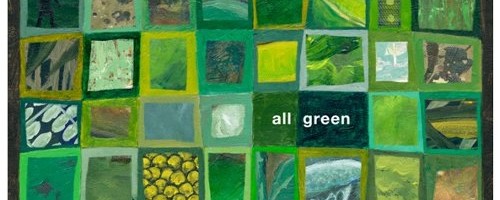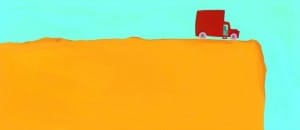One does not usually think of carrots in the same breath as ‘scary’ or ‘unsettling’, unless they are cooked English-style, which is to say, boiled until they are mush. Tasty, yes, but boring. Bereft of personality, you would think, but…you’d be wrong. In Aaron Reynolds and Peter Brown’s new book Creepy Carrots, we are introduced to the other side of this most unassuming of vegetables, the side that is capable of all sorts of mayhem. Tread carefully in your garden, folks. The carrots are watching.

Home Is Where the Dog Is
Today I played with two cats, both of whom are young and spastically agile. My cat is neither of those things. Approaching her 18th year, gone are the days when a fuzzy mouse was worthy of a leap over the back of a couch. Activities that draw her attention are of a less physically strenuous nature: snacks, mild dog-teasing, and sleeping. The aging lab in Elisha Cooper’s new book Homer is of an equivalent vintage, and though life may be winding down, he too has found peace in a slower, quieter existence (minus the dog-teasing.)

Have You Seen Green?
Two things come to mind when reading Green by Laura Vaccaro Seeger. The first is a song by Edie Brickell, also called Green. Barring a rigorous deconstruction of the lyrics (unlikely), the song appears to be about the pleasures of the colour green, especially grass (of the lawn variety) as viewed from the other side of the proverbial fence.
The second is The Age of Miracles by Karen Thompson Walker. This newly published novel about the slowing down of the earth’s rotation (as told by an 11 year old girl) moved me so deeply I see the world differently, or at least, more attentively. I am filled with appreciation for the way things are now, at this particular angle and spin of the earth’s axis.
In my part of the world (Alberta), the land is abundant, wondrously varied, and green. Although we may not be facing a sudden catastrophic event as in The Age of Miracles, parts of the US are experiencing a drought on such a massive scale it rivals the 1930s Depression era, and just a few years ago my province stared down a similar abyss, the evidence of which can still be seen in the canopy. And yet, this summer and the last, we’ve had record rainfall. I never take green for granted. It is the colour of life.
Picks & Tweets from the Illustrated Word
I don’t know about you, but I’ve got a bad case of the dog days of summer (and my cat agrees.) Excessive heat, too many fizzy beverages, and the Olympics have dulled my senses. Not sure what the Olympics have to do with it, as I watched very little of the festivities, but even being in the vicinity of sporting events has a somnambulant effect on me. I did watch the opening and closing ceremonies, and as elated as I was to see Mike Oldfield, I was just as disappointed not to see Kate Bush, although they did play a remix of Running Up That Hill while oppressed-looking folks in white leotards stacked boxes. The best part was the stream of live comments on Twitter, which begs the question, what did we do before hashtags? Instant (and international) sarcastic messaging makes me happy to be alive in the 21st century. Thank you Twitter. And now, more from the Tweetosphere…
Although a long-time Trekkie, I am newly addicted to George Takei’s hilarious Facebook site. On August 6th , Mr Sulu linked the first image of Mars transmitted by the Curiosity rover, pictured above. Marvin. I knew it. Follow the adventures of the Curiosity on ‘his’ awesome Twitter feed.
From Gregory Walters, a post about “required” summer reading for children. I especially like his inclusion of Mad Magazine, which was certainly a staple of my childhood (and occasionally adult) summers.
Julie Danielson from Seven Impossible Things Before Breakfast has just posted a great interview with author/illustrator Komako Sakai. For a second serving of Sakai, here’s my review of The Snow Day.
After watching synchronized swimming on the Olympics (which has scarred me for life), I was reminded of this classic from Saturday Night Live with Harry Shearer and Martin Short. This comedy routine is only marginally weirder. Or maybe not…

A Fairy Tale of Poland
The beauty of writing a blog with a focus on illustration is that I can downplay the story if it’s unremarkable, or if, as with the case of Od Baśni do Baśni (From Story to Story), it is so remarkable that it is beyond comprehension. Not that Polish is particularly remarkable, but it is beyond comprehension, especially for those of us who are not familiar with the language, and/or have a fondness for vowels.
The book was unearthed in the basement of the parents of my brother in law. Sadly, they passed away this last  year, and now their children are sifting through the remnants of their long lives. No one remembers this book, or how it came to be in their possession. Published in 1965, it’s certainly of the era of my brother in law’s childhood, but the provenance is uncertain. Nevertheless, it is now in my hands, if temporarily, and I couldn’t be more tickled.
year, and now their children are sifting through the remnants of their long lives. No one remembers this book, or how it came to be in their possession. Published in 1965, it’s certainly of the era of my brother in law’s childhood, but the provenance is uncertain. Nevertheless, it is now in my hands, if temporarily, and I couldn’t be more tickled.
 Although not familiar with Jan Marcin Szancer, the illustrator of od Baśni do Baśni, his style (at least in this particular outing) is straight out of the sixties. The unusually vibrant colour plates may be a result of the era’s pre-separation printing process, but regardless of how the images made it to the page, Szancer’s illustrations (in colour and black & white) bare a striking similarity to the work of his compatriots outside of Poland. Certainly, Szancer’s humourous and delightfully jaunty approach to illustration is not unlike Ronald Searle or even Paul Galdone, which makes the stories even more tantalizing. Something funny is going on here, but what?
Although not familiar with Jan Marcin Szancer, the illustrator of od Baśni do Baśni, his style (at least in this particular outing) is straight out of the sixties. The unusually vibrant colour plates may be a result of the era’s pre-separation printing process, but regardless of how the images made it to the page, Szancer’s illustrations (in colour and black & white) bare a striking similarity to the work of his compatriots outside of Poland. Certainly, Szancer’s humourous and delightfully jaunty approach to illustration is not unlike Ronald Searle or even Paul Galdone, which makes the stories even more tantalizing. Something funny is going on here, but what?

Dwarf Nose
This morning, while reading Dwarf Nose, the German fairytale by Wilhelm Hauff and Lisbeth Zwerger, I was reminded of Karen Klein, the New York grandmother and bus monitor who was severely taunted by a group of boys on their way to school. Like everyone else who viewed the youtube video (one of the little creeps filmed the dreadful thing), I longed for retribution equivalent to the emotional abuse heaped on the poor woman, but how do you answer such shamefulness? In fairy tales, wickedness is punished, usually in some completely excessive and often spectacularly lethal way, which is not really appropriate (or possible) in the real world. Nevertheless, actions had consequences. In Dwarf Nose, a young boy, described as a ‘fine, handsome son, well built and quite tall for his age’, scolds an old crone for saying nasty things about his mother’s cabbages. Granted, she started it, but when the boy is cursed with the physical attributes he cruelly ridiculed in the old woman, I thought to myself, serves you right, ya little git.
However, I am certain 19th century delinquency is not the point of Dwarf Nose. Indeed, this unusually long tale by Wilhelm Hauff, a contemporary of the Brothers Grimm, is rather nuanced in spite of the mêlée at the vegetable stand. It is also the inspiration for a beautiful series of illustrations by the great Lisbeth Zwerger, who wields her own brand of enchantment, albeit across a modern and considerably less flinty land.
Typical of many fairy tales of the era, Dwarf Nose begins with a family of modest means whose suffering is made infinitely more acute by an unfortunate encounter with the supernatural. To help make ends meet, the cobbler’s wife sells fruits and vegetables at the town market, and her ‘handsome’ son Jacob encourages the local housewives and cooks to buy her wares, often carrying their purchases home for them. He is rewarded well for his efforts, returning to his mother with small coins, or pieces of cake. An old woman in tattered clothes approaches the stand, and proceeds to berate the quality of the herbs and vegetables on display. Wishing to defend his mother, the boy calls the woman a few choice names, casting aspersions on everything from her appearance to her overall filth. The crone ends up buying six cabbages, and upon his mother’s insistence, the boy carries the bags to her cottage. Let the weirdness begin…

Small Things Are Treasures
“May my heart always be open to little birds who are the secrets of living.”*
~E.E. Cummings
Every so often a picture book comes across my desk that makes me weep. It’s not always because the story is sad. Roger Ebert said it’s not sadness in movies that make him cry, it’s kindness. Yes. Sometimes, it’s sheer gratitude that such a beautiful thing exists, or the quiet way an author or illustrator expresses the wonder of being alive. Little Bird by Germano Zullo and Albertine is such a book. It’s joy, kindness, wonder, sadness (but of the wistful sort), and beauty. In short, Little Bird is a treasure.
The story of Little Bird is minimalist, as are the illustrations. Although the artist is Swiss, the block of gold against a cloudless blue sky is like a flat, prairie landscape from western Canada. Perhaps it is canola, or wheat, but the details are few, and the only human activity is a red van, ambling down a narrow, winding road. When it stops at the edge of a crevasse, a peculiar-looking fellow in a plaid shirt and blue overalls departs the cab, walks around to the back, and opens the door.
 A large bird flies out, followed by a flock of beautifully imagined fowl of varying design and colour. This is no ordinary delivery, and it will be no ordinary day. A small black bird, who for some reason has not followed the others into the sky, stares up at the man from the darkness of the van. The man flaps his arms, encouraging the tiny creature to take wing, but the bird doesn’t move. The man sits down next to the bird, offering part of his sandwich. The two of them eat their lunch in amiable silence, until the man makes an even more ridiculous attempt to lure the bird out of the truck. It works, and the black bird joins the flock. Mission accomplished, or so you might think, but as the text promises, some days are different. Little Bird soars in unexpected ways, and the final illustration is magical, but also funny, and deeply moving.
A large bird flies out, followed by a flock of beautifully imagined fowl of varying design and colour. This is no ordinary delivery, and it will be no ordinary day. A small black bird, who for some reason has not followed the others into the sky, stares up at the man from the darkness of the van. The man flaps his arms, encouraging the tiny creature to take wing, but the bird doesn’t move. The man sits down next to the bird, offering part of his sandwich. The two of them eat their lunch in amiable silence, until the man makes an even more ridiculous attempt to lure the bird out of the truck. It works, and the black bird joins the flock. Mission accomplished, or so you might think, but as the text promises, some days are different. Little Bird soars in unexpected ways, and the final illustration is magical, but also funny, and deeply moving.

Coppernickel Goes Mondrian
In a previous post, I discussed picture books that focus on painters. In some instances, the painter in question was a squirrel, or a dog, but all of the characters in one way or another made reference to the human artists who preceded them. None, however, attempted to deconstruct a concept. Coppernickel Goes Mondrian is both a celebration of Dutch artist Piet Mondrian, and an ingenious exploration of the conceptual drive behind the modern art movement. Not an easy thing to do, but Wouter Van Reek has created a little masterpiece of art history in the guise of a children’s book.

Zorro Gets An Outfit
I am currently living with a cat and a dog. I love my cat, but it’s hard to read her emotions. Her expression rarely changes, even as the claws come out. She’s an action cat. Not much of a feeler. The dog, on the other hand, registers every emotion from joy to deep existential pain. It’s true that most of her emotional life revolves around food, and the procurement thereof, but whatever she’s feeling, we know it, from the direction and flaccidity of her ears, to the raised eyebrows, ear-cracking barks, and most especially, the world-weary sigh of a wish unfufilled. As my nieces would say, she’s an EMO. All dogs are EMO, including Zorro, star of the new book by Carter Goodrich, Zorro Gets an Outfit.
In the first book of the series, Say Hello to Zorro, it was Mister Bud who suffers an indignity when a rambunctious pug named Zorro enters his life, wreaking havoc on his meticulously scheduled existence. In Zorro Gets an Outfit, the tables are reversed, and it is the pug who must learn to adapt. Of course, when your name is Zorro, it is inevitable that you will, at some point, sport a cape…





